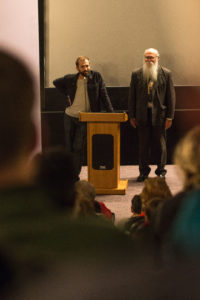By Chloe Wray and Zoe Fruchter
wrayclo@grinnell.edu,
fruchter@grinnell.edu
“Sometimes people have good sheds,” quipped Michael Zahs, lifelong Iowa resident, “retired” history teacher, saver and prolific blood donor. Zahs can now add “documentary film star” to his resume with the release of “Saving Brinton,” a new documentary about a cache of historically significant films from the late 1800s. Zahs and co-director Andrew Sherburne ’01 presented the film on Oct. 25 at the Strand movie theater in downtown Grinnell.
Zahs’s documentary career began with a shed in his yard, which housed rare and sometimes unique remaining films from the Brinton family estate, which Zahs had acquired in the 1980s. So prompted a decades-long odyssey of one man with a forgotten treasure trove, attempting to share his historical discovery with the world.
Frank and Indiana Brinton, wealthy and eccentric Iowa residents and avid travelers, purchased the films in the late 1800s that Zahs later discovered. Bringing international films back to their hometown of Washington, Iowa, the Brintons shared with their community a picture show unlike any in the country, let alone Iowa.
The Brinton film collection included 300 magic lantern slides, non-moving pictures that would be projected onto the screen to tell a story, along with a large collection of short films that featured some of the first special effects in film history. For residents of rural Iowa at the turn of the century, this was a spectacle almost beyond belief.
Although the tale of the Brintons is fascinating, “Saving Brinton” is the story of Zahs, the saver of the films and an extraordinarily charismatic history teacher with a long gray beard. Zahs began showing his films to modestly sized audiences in small town community centers across Iowa. He accompanied the presentation of the silent films at the Strand with commentary on the historical relevance of the techniques and humor. After the University of Iowa recognized the significance of the films and provided Zahs with the resources to restore and promote them, Zahs took his presentations global, showing the films everywhere from Italy to Paris to Washington, D.C.
Despite its increasingly large-scale recognition, “Saving Brinton” follows a theme of community connection. Zahs is not chasing fame or acclaim — he simply wants to share this unique part of Iowa history with those who care to take a look. Iowa pride permeates the film, from the footage of a livestock auction to the Grant Wood paintings that Zahs displays in his home. For Zahs, showing the film in Iowa is of equal significance to showing it at a film festival in Italy, if not more. Following a similar route across Iowa to what the Brintons would have taken to showcase their films, Zahs and Sherburne are premiering their documentary in nine Iowa theaters.
Zahs’ former students have been among the crowd at nearly all of the documentary’s screenings so far, including the Grinnell event. In the Q&A portion following the viewing, many of these students attested to his lessons and role as an influential community member. His greatest lesson to former students and viewers alike lies in the power of examining life on a small scale. As Zahs said on Wednesday, “What I hope that people get from this film is not about the old movies and things but that special things happen and the most special things happen close to home.”



Top photo contributed, following two by Helena Gruensteidl



































































